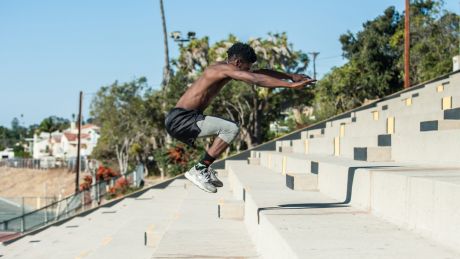The Basics Of Plyometric Training
A PT explains what it is, the benefits and risks, and shares a five-move workout to make your gym routine more explosive – boom!

No matter what your reasons for going to the gym are, it’s worth adding plyometric training to your routine. This explosive style of training, which typically features a lot of jumping, is renowned for its ability to help athletes improve their performance – but it’s also a great way to liven up your training and burn boatloads of calories in a session.
However, it’s also a type of training that can be daunting to the uninitiated and risky to attempt if you don’t know what you’re doing. To get the scoop on everything you need to know to get started with plyometric training, we spoke to Niko Algieri, trainer and co-founder of studio Equilibrium Total Balance, which expands with a new studio opening in King’s Cross in January.
What is plyometric training?
“Plyometrics, or plyo, training is a method which combines strength and speed to produce power,” says Algieri. "Plyometric exercises involve a lengthening or eccentric contraction of the muscles, immediately followed by shortening or concentric contraction of the same muscles – hence the jumping.”
What are the benefits of plyometric training?
“While strength training mostly creates nervous and muscular adaptations to make you stronger, plyometric exercises will help improve explosiveness, which is our ability to generate more force in less time,” says Algieri. “Plyo training, while improving the obvious elements like speed and power, also improves co-ordination and agility, making it one the best forms of training for any competitive sport where you’d need to change directions quickly, jump higher or be faster out of the starting blocks."
Are there any risks to plyometric training?
“Yes! Because of the intensity and explosiveness of the movements there is a greater risk of injury,” says Algieri. “It is essential that movements are executed with proper technique and are at the right level for you.”
So is it suitable for beginners?
“Of course, but it has be performed at a low rep range with guided supervision from a trainer,” says Algieri. “In my experience, plyo training can also add enjoyment to the session and help you build confidence.”
See related
Get the Coach Newsletter
Sign up for workout ideas, training advice, reviews of the latest gear and more.
Use Plyometric Exercises To Make Explosive Gains
Get Faster And Fitter With This Agility Workout
Plyometric Workout
If you’re experienced, try this five-move routine from Algieri.
“Limit yourself to ten reps of each of the below, and do three to four sets of each with 60 seconds of rest in between,” says Algieri.
Jump squat
Sets 3 Reps 10 Rest 60sec
Stand with your feet hip-width apart. Bend at the hips and the knees to lower into a squat with your thighs at least parallel to the ground, then drive back up and jump into the air.
Box jump
Sets 3 Reps 10 Rest 60sec
Stand with a box in front of you (find one that’s around 50cm high at first – don’t go too big too soon) with your feet shoulder-width apart. Drop into a shallow squat and swing your arms back, then swing them forward as you leap onto the box, landing with both feet at the same time.
Jump lunge
Sets 3 Reps 10 Rest 60sec
Step forwards into a lunge on your right foot, lowering until both knees are bent at 90°. Then push back up into a jump, switching your legs while airborne so you can go straight into a lunge position on your left foot when you land.
Press-up burpee
Sets 3 Reps 10 Rest 60sec
From standing, drop your hands down to your feet, then jump your feet back so you finish in a press-up position. Perform a press-up, then jump your feet up to your hands and explode up into the air, taking your hands above your head.
Plyo press-up
Sets 3 Reps 10 Rest 60sec
This is not one for beginners, and even intermediate gym-goers might struggle with it, in which case try dropping to your knees rather than adopting a full press-up position.
From a press-up position, drop down, then push back up powerfully. Lift your palms off the floor and clap them together before you land again.

Nick Harris-Fry is a journalist who has been covering health and fitness since 2015. Nick is an avid runner, covering 70-110km a week, which gives him ample opportunity to test a wide range of running shoes and running gear. He is also the chief tester for fitness trackers and running watches, treadmills and exercise bikes, and workout headphones.
